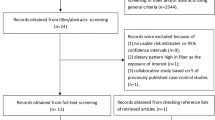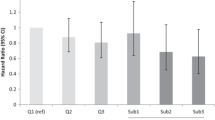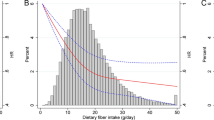Abstract
Objective
To investigate the association of dietary fiber with colorectal cancer
Methods
A total of 85,903 men and 105,108 women completed a quantitative food frequency questionnaire in 1993–1996. A total of 1,138 men and 972 women were subsequently diagnosed with adenocarcinoma of the large bowel. Cox proportional hazards models were used to calculate multivariate adjusted relative risks (RR) and 95% confidence intervals (95% CI) for colorectal cancer.
Results
High consumers of dietary fiber were more active, less overweight, and less likely to be cigarette smokers than low consumers in both sexes. Fiber was inversely associated with colorectal cancer risk after adjustment for age and ethnicity in men (RR = 0.49; 95% CI, 0.41–0.60, highest vs. lowest quintile) and women (RR = 0.75; 95% CI, 0.61–0.92). After further adjustment for lifestyle and dietary factors, the inverse association remained significant in men (RR = 0.62; 95% CI, 0.48–0.79), but not in women (RR = 0.88; 95% CI, 0.67–1.14). Adjustment for the combination of replacement hormone use with either cigarette smoking or body mass index accounted for the lack of association with fiber in women.
Conclusion
Dietary fiber was inversely associated with colorectal cancer risk in men, but its relation to replacement hormone use and other factors affected its inverse association in women.

Similar content being viewed by others
References
American Cancer Society (2006) Cancer facts & figures. Atlanta, GA
Burkitt DP (1971) Epidemiology of cancer of the colon and rectum. Cancer 28:3–13
Committee on Diet, Health, National Research Council (1989) Implications for reducing chronic disease risk. National Academic Press, Washington, DC
Lupton JR, Turner ND (1999) Potential protective mechanisms of wheat bran fiber. Am J Med 106:24S–27S
Cummings JH, Bingham SA, Heaton KW, Eastwood MA (1992) Fecal weight, colon cancer risk, and dietary intake of nonstarch polysaccharides (dietary fiber). Gastroenterology 103:1783–1789
Kritchevsky D (1997) Dietary fibre and cancer. Eur J Cancer Prev 6:435–441
Harris PJ, Ferguson LR (1993) Dietary fibre: its composition and role in protection against colorectal cancer. Mutat Res 290:97–110
Walker AR, Walker BF, Walker AJ (1986) Faecal pH, dietary fibre intake, and proneness to colon cancer in four South African populations. Br J Cancer 53:489–495
Gamet L, Daviaud D, Denis-Pouxviel C, Remesy C, Murat JC (1992) Effects of short-chain fatty acids on growth and differentiation of the human colon-cancer cell line HT29. Int J Cancer 52:286–289
Whitehead RH, Young GP, Bhathal PS (1986) Effects of short chain fatty acids on a new human colon carcinoma cell line (LIM1215). Gut 27:1457–1463
Harris PJ, Ferguson LR (1999) Dietary fibres may protect or enhance carcinogenesis. Mutat Res 443:95–110
Sengupta S, Tjandra JJ, Gibson PR (2001) Dietary fiber and colorectal neoplasia. Dis Colon Rectum 44:1016–1033
Trock B, Lanza E, Greenwald P (1990) Dietary fiber, vegetables, and colon cancer: critical review and meta-analyses of the epidemiologic evidence. J Natl Cancer Inst 82:650–661
Howe GR, Benito E, Castelleto R et al. (1992) Dietary intake of fiber and decreased risk of cancers of the colon and rectum: evidence from the combined analysis of 13 case-control studies. J Natl Cancer Inst 84:1887–1896
Terry P, Giovannucci E, Michels KB et al. (2001) Fruit, vegetables, dietary fiber, and risk of colorectal cancer. J Natl Cancer Inst 93:525–533
Fuchs CS, Giovannucci EL, Colditz GA et al. (1999) Dietary fiber and the risk of colorectal cancer and adenoma in women. N Engl J Med 340:169–176
Pietinen P, Malila N, Virtanen M et al. (1999) Diet and risk of colorectal cancer in a cohort of Finnish men. Cancer Causes Control 10:387–396
Giovannucci E, Rimm EB, Stampfer MJ, Colditz GA, Ascherio A, Willett WC (1994) Intake of fat, meat, and fiber in relation to risk of colon cancer in men. Cancer Res 54:2390–2397
Bingham SA, Day NE, Luben R, Ferrari P et al. (2003) Dietary fibre in food and protection against colorectal cancer in the European prospective investigation into cancer and nutrition (EPIC): an observational study. Lancet 361:1496–1501
Bingham SA, Norat T, Moskal A et al. (2005) Is the association with fiber from foods in colorectal cancer confounded by folate intake? Cancer Epidemiol Biomarkers Prev 14:1552–1556
Park Y, Hunter DJ, Spiegelman D et al. (2005) Dietary fiber intake and risk of colorectal cancer: a pooled analysis of prospective cohort studies. JAMA 294:2849–2857
Kolonel LN, Henderson BE, Hankin JH et al. (2000) A multiethnic cohort in Hawaii and Los Angeles: baseline characteristics. Am J Epidemiol 151:346–357
Stram DO, JH Hankin, Wilkens LR et al. (2000) Calibration of the dietary questionnaire for a multiethnic cohort in Hawaii and Los Angeles. Am J Epidemiol 151:358–370
US Department of Agriculture (1993) USDA nutrient database for standard reference.Release no.10. Riverdale, MD: Nutrient Data Laboratory, Agricultural Research Service
US Department of Agriculture (1991) Nutrient database for nationwide food surveys. Release no. 7. Riverdale, MD: Nutrient Data Laboratory, Agricultural Research Service
Association of Official Analytic Chemists (AOAC) (1990) Official methods of analysis, 15th edn, Sec. 985.29. Arlington, VA: AOAC
Zippin C, Lum D, Hankey BF (1995) Completeness of hospital case reporting from the SEER program of the National Cancer Institute. Cancer 76:2343–2350
Therneau TM, Grambsch PM (2001) Modeling survival data: extending the Cox model. Springer-Verlag, Inc, New York (NY)
Kipnis V, Subar AF, Midthune D et al. (2003) Structure of dietary measurement error: results of the OPEN biomarker study. Am J Epidemiol 158:14–21
Willett W (1998) Nutritional epidemiology. 2nd ed. Oxford University Press, New York, NY
Slattery ML (2004) Physical activity and colorectal cancer. Sports Med 34:239–252
Frezza EE, Wachtel MS, Chiriva-Internati M (2005) Influence of obesity on the risk of developing colon cancer. Gut 55:285–291
Chlebowski RT, Wactawski-Wende J, Ritenbaugh C et al. (2004) Estrogen plus progestin and colorectal cancer in postmenopausal women. N Engl J Med 350:991–1004
Calle EE, Miracle-McMahill HL, Thun MJ, Heath Jr CW (1995) Estrogen replacement therapy and risk of fatal colon cancer in a prospective cohort of postmenopausal women. J Natl Cancer Inst 87:517–523
McMichael AJ, Potter JD (1985) Host factors in carcinogenesis: certain bile-acid metabolic profiles that selectively increase the risk of proximal colon cancer. J Natl Cancer Inst 75:185–191
Jacobs ET, Lanza E, Alberts DS, Hsu CH, Jiang R, Schatzkin A, Thompson PA, Martinez ME (2006) Fiber, sex, and colorectal adenoma: results of a pooled analysis. Am J Clin Nutr 83:343–349
Institute of Medicine (2005) Dietary reference intakes for energy, carbohydrate, fat, fatty acids, cholesterol, protein, and amino acids. The National Academies P, Washington, DC
Acknowledgment
This work was supported in part by grant R37 CA054281 from the National Cancer Institute, U.S. Department of Health and Human Services.
Author information
Authors and Affiliations
Corresponding author
Rights and permissions
About this article
Cite this article
Nomura, A.M.Y., Hankin, J.H., Henderson, B.E. et al. Dietary fiber and colorectal cancer risk: the multiethnic cohort study. Cancer Causes Control 18, 753–764 (2007). https://doi.org/10.1007/s10552-007-9018-4
Received:
Accepted:
Published:
Issue Date:
DOI: https://doi.org/10.1007/s10552-007-9018-4




